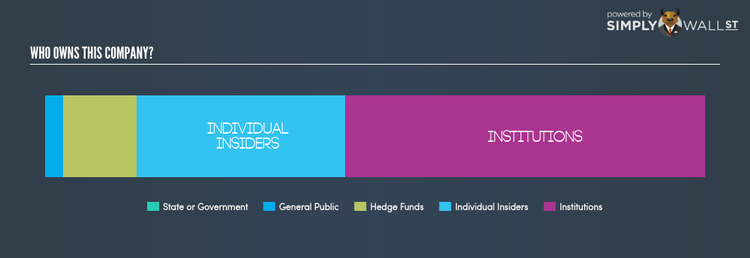Who Owns esure Group plc (LON:ESUR)?

In this analysis, my focus will be on developing a perspective on esure Group plc’s (LSE:ESUR) latest ownership structure, a less discussed, but important factor. When it comes to ownership structure of a company, the impact has been observed in both the long-and short-term performance of shares. Since the effect of an active institutional investor with a similar ownership as a passive pension-fund can be vastly different on a company’s corporate governance and accountability of shareholders, investors should take a closer look at ESUR’s shareholder registry.
Check out our latest analysis for esure Group
Institutional Ownership
Institutions account for 54.42% of ESUR’s outstanding shares, a significant enough holding to move stock prices if they start buying and selling in large quantities, especially when there are relatively small amounts of shares available on the market to trade. Although ESUR has a high institutional ownership, such stock moves, in the short-term, are more commonly linked to a particular type of active institutional investors – hedge funds. With hedge funds holding a 11.12% stake in the company, its share price can experience heightened volatility. But I also examine other ownership types and their potential impact on ESUR’s investment case.
Insider Ownership
I find insiders are another important group of stakeholders, who are directly involved in making key decisions related to the use of capital. In essence, insider ownership is more about the alignment of shareholders’ interests with the management. ESUR insiders hold a significant stake of 31.60% in the company. This level of insider ownership has been found to have a negative impact on companies with consistently low PE ratios (underperformers), while it has been positive in the case of high PE ratio firms (outperformers). It’s also interesting to learn what ESUR insiders have been doing with their shareholdings lately. While insider buying is possibly a sign of a positive outlook for the company, selling doesn’t necessarily indicate a negative outlook as they may be selling to meet personal financial needs.
General Public Ownership
The general public holds 2.73% stake in ESUR, which represents a relatively small class of owners. This size of ownership may not be enough to sway a policy decision in their favour, but they can still make a collective impact on company policies if it aligns with other large shareholders.
Next Steps:
With significant institutional ownership, including active hedge, existing investors should seek a margin of safety when investing in ESUR. This will allow an investor to reduce the impact of non-fundamental factors, such as volatile block trading impact on their portfolio value. However, ownership structure should not be the only focus of your research when constructing an investment thesis around ESUR. Rather, you should be looking at fundamental drivers such as the intrinsic valuation, which is a key driver of esure Group’s share price. I highly recommend you to complete your research by taking a look at the following:
1. Future Outlook: What are well-informed industry analysts predicting for ESUR’s future growth? Take a look at our free research report of analyst consensus for ESUR’s outlook.
2. Past Track Record: Has ESUR been consistently performing well irrespective of the ups and downs in the market? Go into more detail in the past performance analysis and take a look at the free visual representations of ESUR’s historicals for more clarity.
3. Other High-Performing Stocks: Are there other stocks that provide better prospects with proven track records? Explore our free list of these great stocks here.
NB: Figures in this article are calculated using data from the last twelve months, which refer to the 12-month period ending on the last date of the month the financial statement is dated. This may not be consistent with full year annual report figures.
To help readers see pass the short term volatility of the financial market, we aim to bring you a long-term focused research analysis purely driven by fundamental data. Note that our analysis does not factor in the latest price sensitive company announcements.
The author is an independent contributor and at the time of publication had no position in the stocks mentioned.

